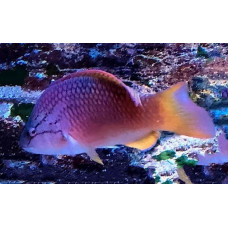Latin name
Pseudolabrus eoethinus
Other name
Pseudolabrus eoethinus
Identification
This species was first officially described in 1846 by the Scottish naturalist and naval surgeon John Richardson (1787-1865) as Labrus eoethinus, and the location of the species was given as Canton, China. Coenraad Jacob Temminck & Hermann Schlegel had previously applied the name Labrus rubiginosus to specimens they examined, but this name was incorrect, although Pieter Bleeker used this name for the type species of his new genus Pseudolabrus in 1862.
Features of fish fins
Dorsal spines (total): 9; Dorsal soft rays (total): 11; Anal spines: 3; Anal soft rays: 10.
Fish colouring
Juvenile Red Naped Wrasse have a brown body, darker on the back. They have dark stripes and spots on the body and head. Adults have a purplish red body at the front and yellowish at the back. Several dark stripes run down the body.
Distribution
Widespread in the northwest Pacific: southern Japan, Taiwan and the South China Sea.
Habitat
A subtropical marine species. Occupies rocky reefs in waters no deeper than 30 metres (98 feet).
Size
This small species is standard up to 207 millimetres (8.1 inches) long.
Behavior
This species lives in small harems consisting of one territorial male and several females.
Food and feeding habits
P. eoethinus associates with Cheilodactylus (Goniistius) zonatus and feeds mainly on crustaceans and molluscs.
Reproduction
Spawning takes place from mid-November to mid-December, with the fish mating and laying eggs in the male's territory.
Fishing
Amethyst anthias are of no commercial interest in fisheries.
Relationship with a person
Harmless.
| Classification | |
| Phylum | Chordata |
| Class | Actinopterygii |
| Squad | Labriformes |
| Family | Labridae |
| Genus | Pseudolabrus |
| Species | P. eoethinus |
| Features | |
| Conservation status | Least Concern |
| Habitat | Pelagic |
| Life span, years | No information |
| Maximum body weight, kg | No information |
| Maximum length, cm | 20,7 |
| Sailing speed, m/s | No information |
| Threat to people | Not edible |
| Way of eating | Planktonophage |
Red naped wrasse
Tags: red naped wrasse



